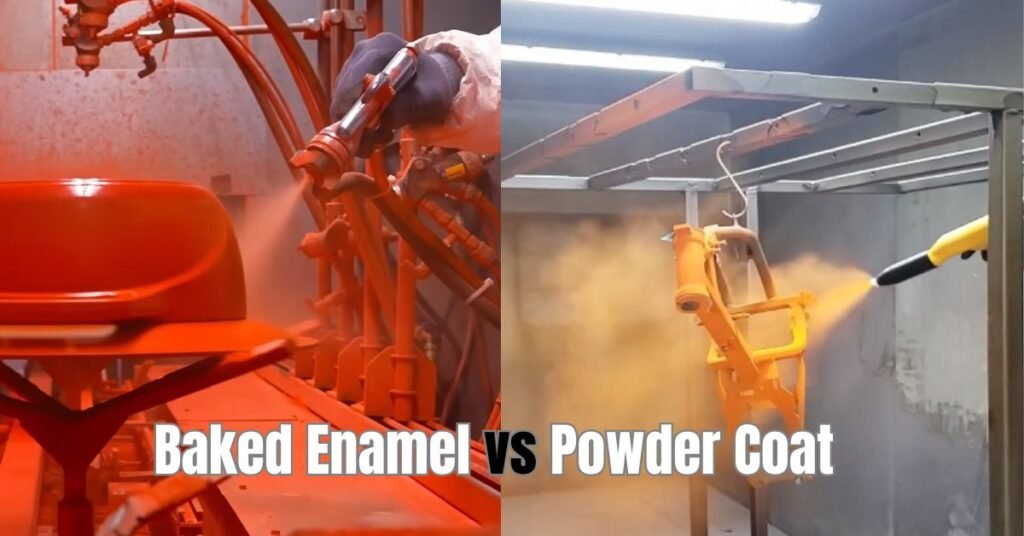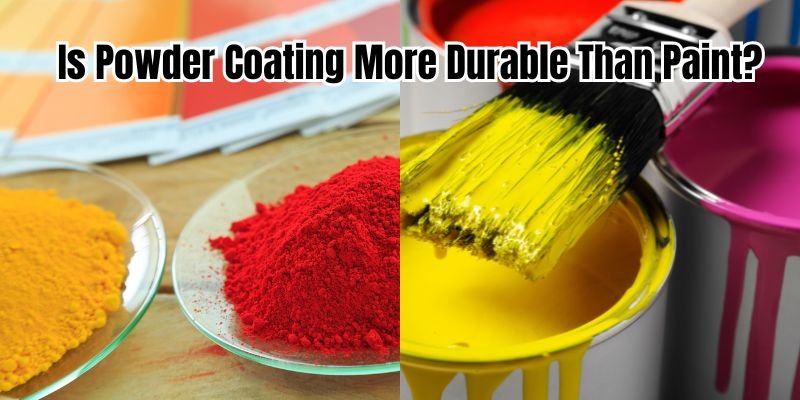There is no one-size-fits-all answer to the question of whether powder coating is cheaper than painting; however, the answer largely depends on several factors. Typically, the choice between powder coating and painting will depend on the type of project, its size, complexity, and the desired finish.
This article provides an overview of the relative costs of powder coating vs painting, as well as the advantages and disadvantages of each so that an informed decision can be made.

What is Powder Coating and Is It Cheaper Than Painting?
Powder coating is an advanced method of applying a decorative and protective finish to a variety of materials and products. It is a process in which a dry powder composed of finely ground particles of pigment and resin is applied electrostatically to the surface to be coated and then cured under heat. The result is a uniform, durable, and attractive finish.
The powder coating process has several advantages over traditional painting. The first is that it is applied electrostatically, which gives a uniform distribution of the powder over the entire surface of the material, ensuring a smooth and even finish. Additionally, the powder does not require a solvent or binder, which contributes to a low emissions process.
This makes it a highly sustainable and environmentally friendly finishing process. In terms of affordability, powder coating is often cheaper than painting. This is because it requires fewer coats and materials than a liquid paint coating. Additionally, powder coating creates fewer overspray issues and waste than other coating methods, making it more cost-effective.
The cost of powder coating depends on the size of the project and the material being coated, as well as other factors such as the cost of electricity and how long the curing process takes.
In general, it has been found to be more economical than liquid paint finishes. It is important to consider any special requirements of a project before making a decision about which coating process is best for the job.
The Pros and Cons of Powder Coating and Painting
Powder coating and painting are two common surface finishing processes used to protect and decorate metal objects. Both offer unique advantages and limitations.
Pros of Powder Coating
- Extremely durable finish resists chipping, peeling and abrasion
- Thick uniform coat without brush strokes creates smooth professional aesthetics
- No solvents produces zero VOCs making it eco-friendly
- Wide range of colors and finishes like metallic, wrinkles, gloss, matte etc.
- Can apply thicker coatings than paint without running or sagging
- Fully cured in minutes allowing fast process times
- Ideal for coating metals but can also be used on other materials like medium density fiberboard (MDF) when combined with a conductive primer
Cons of Powder Coating
- Requires high initial investment in powder coating equipment
- Only adheres to conductive surfaces limiting base material options
- Reclaiming overspray powder is required for efficiency
- Pretreatment with sandblasting essential for strong adhesion
- Limited number of certified applicators compared to painters
Pros of Painting
- Very low setup costs within reach of individual users
- Applies easily to vast array of base materials – wood, metal, plastic, drywall etc.
- Huge range of specialized paints for different applications
- Touch ups and color changes simpler than powder coating
- No need for dedicated workspace, basic ventilation suffices
Cons of Painting
- Multiple coats often required extending project time
- Brush strokes may be visible impacting smoothness of finish
- Paint fumes contain VOCs unless using specialized low VOC formulations
- Shorter lifespan requiring more frequent repainting
- Improper application leads to drips, uneven coats and brush marks
- Dirt pickup, yellowing and flaking over time reduce durability
Weighing the pros and cons of both processes helps determine the best method for specific application needs. Powder coating excels for durable uniform metal finishes while painting provides accessible surface protection for diverse materials.
Cost-Effective Option: Powder Coating vs. Painting
Powder coating and painting are two of the most popular methods used to protect and customize metal surfaces. Deciding which option is best for a particular project can be difficult. To assist in making an informed decision between the two, we have outlined key information concerning powder coating and painting that can help in uncovering the most cost-effective option.
Powder Coating
Powder coating involves the application of a dry powder that is sprayed onto a metal surface. The powder then melts and bonds to the surface, creating a uniformed, protective coating that is resistant to corrosion, scratches, and other elements.
Powder coating offers a consistent finish, and is available in a variety of colors and textures. Additionally, powder coating contains no solvents, making it more environmentally friendly than many other methods of coating.
Painting
Painting involves the use of liquid paint or primer and can be done with either a roller or spray gun. Painting is an effective way of protecting metal surfaces from corrosion and other elements. Painting is also available in a variety of colors and can provide a unique look to a piece of metal.
Cost
When it comes to cost, powder coating is typically more expensive than painting. Powder coating can cost between $50 to $100 per square foot while painting typically runs between $35 and $50 per square foot. This difference in cost is largely due to the specialized equipment required to apply powder coatings.
Durability
Powder coating offers superior performance in terms of corrosion resistance, scratches, and wear and tear when compared to painting. It is also more resistant to environmental elements such as UV light and extreme temperatures.
Read More: Is powder coating more durable than paint?
When attempting to decide between powder coating and painting, cost and durability should be taken into consideration. Powder coating is typically more expensive than painting, but offers superior performance with regards to corrosion resistance, scratches, and wear and tear. Ultimately, the most cost-effective option will depend on the individual project and desired outcome.
Is Powder Coating a More Cost-Effective Option Compared to Paint for Wood?
Powder coating wood: a detailed examination reveals that it can be a more cost-effective option in comparison to painting. Not only does powder coating provide a durable finish, but it also eliminates the need for primer and regular touch-ups. With excellent resistance to chipping, cracking, and fading, powder coating wood offers long-term savings and a high-quality aesthetic appeal.
Is Powder Coating Cheaper Than Painting? An Honest Cost Comparison
In general, powder coating can be more cost-effective than traditional painting for certain applications, but the overall cost comparison can depend on several factors. Here’s an honest cost comparison between powder coating and painting:
Material and Equipment Costs
Powder Coating: The initial setup cost for powder coating can be higher due to the need for specialized equipment like powder guns, curing ovens, and booths. However, once set up, powder coating materials can be more cost-efficient as there is minimal overspray and waste.
Painting: Traditional painting may have lower initial equipment costs, but the price of paint, solvents, and other supplies can add up over time. Paint also tends to have higher wastage due to overspray.
Labor Costs
Powder Coating: Powder coating can require skilled labor for proper application, but the process is generally faster than painting, which can lead to reduced labor costs.
Painting: Painting may require more labor hours due to the need for multiple coats and drying times. Skilled painters are also necessary for achieving a high-quality finish.
Preparation and Pretreatment
Powder Coating: Surface preparation and pretreatment are crucial for successful powder coating. The cost of cleaning, sandblasting, and applying pretreatment chemicals can contribute to the overall cost.
Painting: Similar to powder coating, surface preparation is important for painting. The cost of primers, fillers, and other preparation materials needs to be considered.
Application Efficiency
Powder Coating: Powder coating is more efficient in terms of material usage since overspray can be collected and reused, minimizing waste.
Painting: Traditional painting methods often result in more overspray and wastage of paint, leading to higher material costs.
Environmental Considerations
Powder Coating: Powder coating is generally considered more environmentally friendly as it produces less volatile organic compounds (VOCs) compared to traditional painting, which requires solvent-based paints.
Painting: Painting may release more VOCs into the atmosphere, which can lead to higher compliance costs with environmental regulations.
Durability and Longevity
Powder Coating: Powder coating tends to be more durable and resistant to chipping, fading, and corrosion, which can result in longer-lasting finishes.
Painting: The longevity of a painted finish can vary based on the quality of the paint used and the application process. Some paints might require more frequent touch-ups or repainting.
Customization and Aesthetics
Powder Coating: Powder coating offers a wide range of color options and finishes, but changing colors or designs can be more complex and costly.
Painting: Painting allows for more flexibility in terms of color changes and intricate designs, but it might require more labor and time to achieve certain effects.
Final Thoughts
Whether powder coating is cheaper than painting depends on the specific project’s requirements, size, complexity, and long-term considerations. While powder coating might have higher upfront costs, its efficiency, durability, and environmental advantages can make it a cost-effective choice over the long run, especially for applications where a high-quality, long-lasting finish is essential. It’s recommended to obtain quotes from reputable powder coating company to get a more accurate cost comparison for your specific project.


